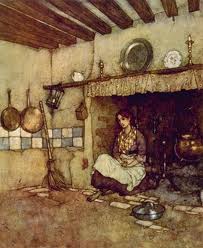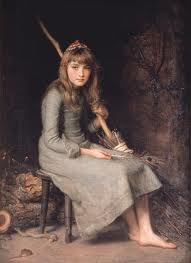Podcast: Play in new window | Download
Let me tell you a little story about Meg, a top advertising executive in Los Angeles, who discovered her connection to Cinderella and thereby found herself.
Meg was successful. She was making something like $400,000 a year, but was itchy, never content with herself. She spent almost a quarter of her income on clothes, make-up and “body work”. She was a little over fifty years old, still pretty glamorous, especially in her expensive clothes, but her confidence was weakening. She found it hard to show up at business meetings, or if she did show up, she felt compelled to leave as soon as she could get away. She had this fear that sooner or later the other people would discover that she was actually not as attractive as they had thought she was. She had this sense that deep down she was worthless and someday she would be exposed.
Meg held herself to very high standards of appearance and behaviour, which she had learned from her mother, a perfectionist who had always criticised Meg when she had been young. She fell into the trap of giving herself only two options: either she achieved the perfection of her mother’s standards, or she was nothing. Usually, even though she strove for perfection, she felt she was worthless.
Now, here’s how Cinderella comes into our story.
Meg had no children, but she had a good rapport with her niece, and when she would visit, one of her favourite things was to read a good-night story to the girl. Once, when she was reading Cinderella, Meg found herself choking up. She held her composure long enough to turn out the light and then make a quick exit from her sister’s place, but in the taxi going home she burst into sobs. Why was this? What was there about the Cinderella story that affected her so strongly?
Meg was not stupid, and knew a thing or two about popular psychology. She knew, for instance, that we often project our own hidden selves onto the characters we meet in books, or films, or songs. When we cry over a story or a song, especially when we are crying harder than the story or song warrants, the chances are we are really weeping about ourselves. Meg began to wonder, then, if Cinderella represented something deep within herself.
What struck her first was Cinderella’s mother telling her that her place is in the ashes. As she sat quietly with this image from the story, waiting to see what came next, she could hear her own mother yelling at her when she was a girl. “You can’t go out with that coat on. It doesn’t match your dress and shoes. You’re a slob!” or “You only came in third in your class? You’re a failure. You’re never going to get anywhere. You belong in the lowest hole on earth.” Yes, these phrases still stung her after all these years, but, she realised, they meant exactly what the wicked stepmother in the story said: You belong in the ashes, in the most degrading place in the house.
Meg began to realise that she had been carrying this all her life. She was still the little girl whose place was in the ashes. But like Cinderella, she had a fairy godmother to give her the power to rise out of the ashes. Several fairy godmothers, in fact: her hairdresser, her make-up consultant, her six or seven fashion designers. If she wore fashionable clothes and used the right kind of make-up and body language, she would finally be able to “go to the ball” and become attractive to others. But like Cinderella, there was a restriction. Her magic outfits did not last the whole night. Meg lived in fear that the clothes and make-up would not always disguise her. Those midnight bells, she felt, would reveal the rags that she felt belonged to her true self.
Meg read again, slowly, the story of Cinderella, watching to see if anything else in the story would produce a strong emotional response. And yes, what caught her – not in tears this time, but in a kind of delight – was the part where the fairy godmother touched Cinderella with her wand and “her clothes turned into cloth of gold and silver, all beset with jewels”. What was it about the clothes that moved Meg?
She began to visualise Cinderella at the ball in her gold and silver dress, all covered with jewels.
That kind of dress would be pretty heavy, that’s for sure. How could she move in it? Gold and silver? All that metal? And the jewels? She couldn’t move without fearing that the jewels would fall off or get in the way. But she certainly would have sparkled. All that gold and silver and gemstones would have caught the light as she danced.
All eyes would be on her, like some kind of featured product at a trade show. But there’s a flaw in the product. It has a short best-before date. It disintegrates at midnight.
So although she’s glittering now, this won’t last. The identity she sees in herself is only temporary glitter. She’s the best in the room – at least for the moment – but she can’t keep this up. Of course she has to return to the ashes.
This was depressing, but Meg began to see it was not hopeless. In the story, Cinderella triumphed when she claimed the glass slipper left behind at the ball. After that, Cinderella was transformed into even more gorgeous clothes, and this time they were permanent, symbolising a permanent shift of identity.
How could Meg claim her own glass slipper and a permanent transformation? What would the glass slipper be in her case?
Could she find some moment in her life that compared to the moment when Cinderella left the ball? Could she recall a time she fled from some important occasion in fear that she would be exposed? How about that time a few weeks ago when she had to organise and host a large and important company lunch for many of the biggest buyers?
I was pretty anxious preparing for this big event and allowed myself to buy a new outfit for this occasion. On the day of the lunch, I spent most of the morning arranging all the details with my assistants. I knew I had good taste in organising these occasions and had a better sense than others in preparing things like the seating charts. The real reason for this big lunch was to impress the clients with how savvy and glitzy and sexy our company was. There was a lot of money riding on this, as well as prestige. And of course my own reputation in the company. Could I live up to all this? So much depended on how I looked. I had been using a new kind of face cream and I’m sure my skin looked smoother than before, but it was hard to tell. I spent a long time choosing my outfit, something that would draw the men’s eyes to my body but keep their eyes from discovering what it really looks like.
Hélène, my special designer, was like my fairy godmother. She delivered the dress to me that morning and helped me get ready in the executive lounge. “Meg,” she said to me, “you look transformed in this dress!” I guess it was like waving a magic wand, especially after I was feeling so worn out and messy after the hectic morning. I wasn’t wearing gold and silver threads like the dress the fairy godmother gave to Cinderella, but once I put on that outfit, I did feel sparkly. I felt I could go out and face anyone.
The lunch went well. Meg gave a sparkling presentation and managed to walk around talking to the important people, who all seemed very pleased. In fact, like Cinderella at the ball, she was the centre of attention and everyone praised her. But like Cinderella, there seemed to be a limit to this good time. Meg didn’t hear the stroke of midnight, of course, but she began to fear that the magic would soon begin to wear off. She felt her lipstick might have become a little smeared when she wiped her lips after the coffee, and she had this nagging suspicion that her beautiful dress had become all wrinkled in the back from the time she turned in her chair to talk to the man next to her.
She wanted to get out of there as soon as she could, though, and managed to manoeuvre things so that she could leave after the presentations, before anyone noticed the smeared lipstick or wrinkled dress – if indeed the lipstick was smeared or the dress wrinkled. She got away safely, but in the process aroused those old feeling that the only place she could feel secure was hidden away in the solitude of the cinders.
And now here was the question Meg had to ponder: What, in this situation, corresponded to the glass slipper? What was it that she had left behind her with the others that belonged to no one else, and would fit only her? What was it that could be the key to her true worth?
She thought of all sorts of possible glass slippers: her dress sense, her organisational ability, but these were not unique to her. And then she recalled something in an e-mail one of her big clients sent to her the day after the luncheon. He said he was particularly pleased to have had the chance to talk with her at the meal, because Meg was not like the other people he meets in the business world, who can’t talk about anything except their work or maybe sports. He said Meg really seemed interested in what he was talking about – the elections, those new discoveries in relieving back pain, and the problem he had been having with his son at school. “I know you had a million things to do yesterday,” he wrote, “but I really appreciated the chance to talk to someone sympathetic, especially about my son.”
At the time, this didn’t seem a big deal to Meg. It was good to talk with that man; it took her mind off the pressures of the event for fifteen minutes to interact with him and think about his concerns, not her own. She knew his brother was in politics so of course she wanted to hear his inside take on the elections. It wasn’t hard to follow his talk about back pain because her uncle suffered badly and always talked about cures and remedies, and it became a kind of game to compare different treatments. And as for the problem with his son at school, well, Meg knew quite well what it felt like to be a disappointing child – just ask her mother – and so she could speak from a fresh point of view.
Could this be the glass slipper? – just that ability to converse quietly and sympathetically with another person? Making personal contact with someone in the middle of a formal business occasion? Could it be this simple? Well, why not? Other people could be sympathetic, but none in quite the same way as Meg could be.
Let me claim as my glass slipper this ability to connect to others for a few minutes of personal contact in the midst of a fancy business affair. This is what makes people like and admire me, not my fit body, or my outfits. They are temporary gifts, from the fairy godmother. This ability to make real contact with people is mine for keeps.
Cinderella’s life was immediately transformed. That is what happens in a fairy tale. In real life the transformation may take longer. Meg had to wear her slipper for some time before she was able to sit comfortably through a whole business meeting without panic, or could resist buying new clothes or accessories for every new event, and she still found herself depending on her attractive presence to get her through her meetings, and still doubted that she was looking as good as she’d hoped. But something very important inside her had changed. She not only knew that her real asset was her ability to bring that personal touch to the business world, but she also could call that asset her glass slipper and so connect her personal experience to the universal pattern of the Cinderella story. This gave her struggle with low self-esteem a significance and meaning grounded deep into her heart and imagination. It was hers to keep.




…”the universal pattern of the Cinderella story”… that is a right-on literary phrase,as I have learned from my own deeper look at so-called children’s literature. Did you know, for instance, how many cultures have their own Cinderella story in their own children’s literarure? There is a Korean Cinderella story, a Native American one, an Irish one etc, which differ in details but hold to the same universal pattern and theme as Perrault’s French one, that of a woman being valued for her inner worth…I very nearly wrote a paper on this topic for Robert’s Louis’s Children’s Literature seminar in Mildenhall, but finally focused on a single Irish court fairy tale instead.
Due to my history and interest with the Cinderella pattern though, I truly appreciate the relevance of the updated story. Meg (Whitman) just ran for and lost to the Governor of California, the state I have returned to live in: You can’t lose if you have transformed into winning your self.
hey , thank you so much for this
my name is meg, too and i really can relate to a lot of this
– i found it looking for fairy tale pics by edmund du lac
thank you and who are you ? xxxxxxxxxxxxxxxxxx
Dear Meg, Thanks for your kind words. I’m glad what I was saying resonated with you. You can see more on this theme by listening to some archives from old Evening under Lamplight shows. The Cinderella theme, for instance, reappears in the show Being Cinderella (pretty much the same approach but with music as well), and then there’s another show on Little Red Riding Hood. You might find other shows you’ll like too, if you go in for this way of looking at things.
I stopped doing Evening under Lamplight at the end of 2012, but there is talk now of reviving it. I’ll probably give the new series a Greek Myths theme. I have lots of plans for it, but I might drop the music. It’s all up in the air.
Let me know about how this connects to you and your interests. (It’s better to get to me at rla@momentsunderlamplight.co.uk rather than in this column.
all the best,
Robert-Louis
Thank you !! I will look it all up and sorry I didn’t get back sooner. xxxxxx